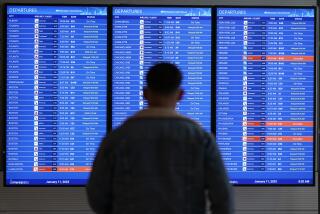Airline Industry Needs to Downsize, Analysts Say
- Share via
SHANGHAI — Airline chief executives, meeting Sunday as a group for the first time since the Sept. 11 attacks, face further losses on top of last year’s $17 billion unless they shrink the industry by a third, analysts said.
British Airways, AMR Corp.’s American Airlines and other major carriers won’t return to profitability by trying to fill their planes and win market share with low ticket prices as they are now, said Chris Tarry, an airline analyst at Commerzbank.
“It’s a simple issue of supply and demand, but it’s one that airlines have failed to address for 50 years,” Tarry said. “This is an industry that’s been suffering from mass delusion about productivity and costs.”
The airline industry’s profit margin averaged just 3% from 1947 to 2000, even before the Sept. 11 attacks cut air travel by a third and led to losses that were greater than all the profit ever generated by airlines in the history of flying.
While carriers are working to reduce costs to cope with the fall in demand, firing more than 10% of staff worldwide, they need to embrace fundamental change, said Rigas Doganis, an industry consultant and former chief executive of Greece’s Olympic Airways.
“The traditional airline network model isn’t sustainable,” Doganis said. “It’s overextended. The big airlines need to reduce their short-haul operations and the smaller ones need to cut back on long-haul flying.”
By reducing capacity in this way, carriers will be able to halt a decline in prices that’s steadily eroding their average yield, or revenue per seat, and undermining their efforts to make a profit, analysts said.
The gathering of industry chief executives at the International Air Transport Assn.’s annual meeting in Shanghai is seeking to address how carriers can develop their responses to the environment left by the attacks, said Doganis, who will chair one of the sessions.
The industry needs to be reduced by at least 30% in terms of seating capacity to achieve sustainable profits, said Tarry, the Commerzbank analyst.
Fares have fallen so much that the price of a 1,000-mile flight within Europe 10 years ago is the same as a seat across the Atlantic today. The reduction has meant that profits are no longer assured even when times are good, said Tarry, who predicts airlines will have combined losses of at least $10 billion this year.
Excess capacity might be eliminated by consolidation, though government regulations now restrict mergers mainly to carriers from the same country. British Airways’ repeated attempts to take over KLM Royal Dutch Airlines have stumbled on the rules restricting access to airports worldwide to national carriers.
The International Air Transport Assn.’s outgoing director general, Pierre Jeanniot, has told airlines they can’t blame their situation entirely on Sept. 11. Even before the attacks the industry had been expected to post a $2.5-billion loss last year.
“CFOs should have been more vigilant and insisted on more actions being taken to prepare for the storm,” he said.
More to Read
Inside the business of entertainment
The Wide Shot brings you news, analysis and insights on everything from streaming wars to production — and what it all means for the future.
You may occasionally receive promotional content from the Los Angeles Times.










